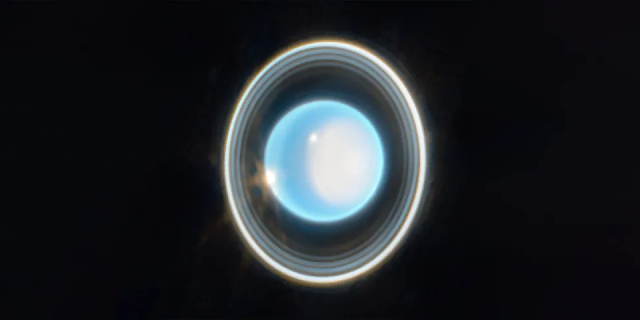
It's real, and it's fantastic.
JWST has done it again. Recently, the team behind the James Webb Telescope released its new images of Uranus, the seventh planet from our Sun. And they’re stunning.
Uranus has been an oddball for a lot longer than we’ve been looking at it. Most uniquely, the multi-ringed ice giant is the only planet to spin on its side, almost perpendicular to its orbit. The above photo isn’t just turned sideways—the rings actually go that way.
The planet also has a number of other interesting features, including a transient polar cap that seems to appear in the summer and disappear in the winter. We don’t yet know what causes that area to brighten and dim the way it does, but researchers are hoping the new data Webb has collected along with these images will provide a bit of insight into the phenomenon.
Additionally, JWST has given us an incredibly clear glance at 11 of Uranus’s 13 rings, which vary in brightness from ring to ring so much that it’s often difficult to distinguish one from the other. To get 11 on full display right off the bat is impressive, and researchers believe future Webb imaging will reveal the other two in short order.

And we can’t look past the collection of moons either. Uranus is thought to have 27 moons, and we can see the six brightest in this image above. But if those numbers sound like an unimpressive fraction, it’s important to remember that this photo was taken from almost two billion miles away with just a 12-minute exposure and two filters. Scientists are certain they can up the moon count on future observations.
There’s actually been an uptick in interest in Uranus recently. Last year, we saw the release of the 2022 Planetary Science and Astrobiology Decadal Survey—also known simply as the Decadel—which is a once-a-decade report put together by scientific delegates to help guide funding in the field for the next ten years.
And one of the targets singled out in the Decadel for deep study in the next decade was Uranus and its system of moons. As a result, there are now plans in the works to send a flagship mission called the Uranus Orbiter and Probe to the planet sometime in the near future to study Uranus and its satellites.
Until we can actually get a craft into the planet’s vicinity, these images seem like a great start for future investigations of Uranus. Long live JWST.





1 Comments
I do not see much difference of this Uranus shot from a photo taken of Uranus 20 years ago.
ReplyDelete